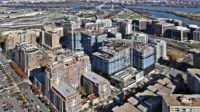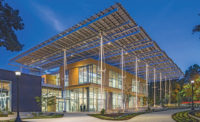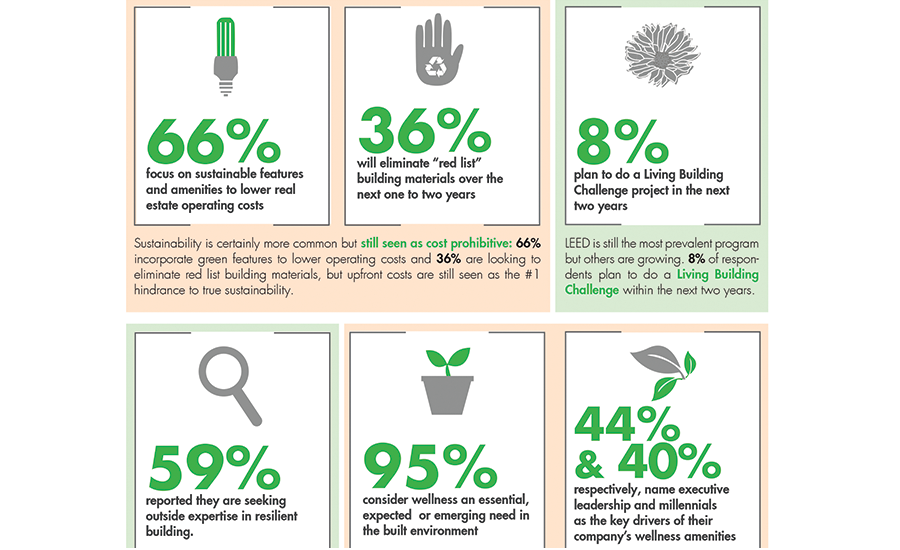Ultra-Energy-Efficient Windows are on the Horizon

Insulated unit, with a thin central pane, fits into the frame of a standard double-glazed unit but offers twice the insulation against heat loss.
COURTESY OF STEPHEN SELKOWITZ/LBNL

Insulated unit, with a thin central pane, fits into the frame of a standard double-glazed unit but offers twice the insulation against heat loss.
COURTESY OF STEPHEN SELKOWITZ/LBNL

Survey of 106 Structure Tone clients reveals that 33% do not focus on greening buildings.
SOURCE: STRUCTURE TONE INC.



Windows guru Stephen E. Selko-witz is on a new campaign to usher to market super-energy-efficient insulated-glazing units. His brainchild is a thin triple-glazed unit that can double the insulation value of a retrofitted double-glazed unit without changing its bulk or weight.
The “thin triple” retooling is based on off-the-shelf products and does not alter a double-glazed unit’s sash and frame, said Selkowitz, senior adviser for building science at the U.S. Dept. of Energy’s Lawrence Berkeley National Laboratory (LBNL), at the U.S. Green Building Council (USGBC) 16th Annual Greenbuild International Conference and Expo, held Oct. 5-7 in Los Angeles.
The goal is to have the units—a 0.028-in. outer pane and a 0.118-in. inner pane with a 0.043-in. pane between them—mainstream and widely available, first for residential buildings in cold climates, by 2020, said Selkowitz, ENR’s 2014 Award of Excellence winner (ENR 4/7/14 p. 44).
According to DOE, window-energy impacts cost U.S. owners $50 billion each year. Of that, heating energy costs are about $17 billion, said Selkowitz.
The cost to develop a thin-triple technology platform and solve some minor manufacturing issues, such as handling the thin pane, is $3 million to $4 million, Selkowitz estimates. To get the product to market, he is planning to create a consortium of stakeholders, including the U.S. Dept. of Energy, owners, builders, designers, and glass suppliers and their trade groups. “If I can get one or two of the top 10 or 15 window companies, everyone else will follow,” he said.
At Greenbuild, which had 20,000 registrants, USGBC launched its LEED green-building certification system user group for contractors. “Through a user group, we can give contractors additional bandwidth,” said Rhiannon Jacobsen, USGBC’s vice president of strategic initiatives. USGBC has user groups for industrial; retail and restaurants; hospitality and venues; and commercial real estate.
One issue for contractors—and all building-team members—is the more-stringent LEED Version 4 materials credits, which, for the first time, require environmental product declarations, materials ingredient reporting and sourcing of raw materials. The LEED v4 materials credits remain a sensitive subject, especially because LEED 2009 “sunsets” on Oct. 31.
Structure Tone, one of 14 members of the contractor group, released results of a green survey of 106 clients. “Sustainability is certainly more common but still seen as cost-prohibitive,” says the survey, which notes that 74% of the anonymous respondents say initial cost is the top barrier to greener buildings.
Two-thirds of the respondents said they incorporate green features to lower operating costs; 59% reported they are seeking outside expertise in resilient buildings; 36% said, over the next one to two years, they are looking to eliminate building materials that contain known toxins; and 8% said they plan to do an ultragreen Living Building Challenge (LBC) project in the next two years.
“I was most surprised by the 8% figure and also that 19% think of LBC as a respected third-party certification system,” said Jennifer Taranto, Structure Tone’s director of sustainability.
At the conference, USGBC announced a new technology organization, “arc,” led by CEO Scot Horst, USGBC’s current chief product officer. Arc is a digital platform that will allow any user to measure a building’s performance, make improvements and benchmark new performance against the old, said USGBC.
Green Business Certification Inc. (GBCI) and the Environmental Defense Fund announced they will work to develop, deliver and promote the Investor Confidence Project as a global underwriting standard for energy-efficient projects.
Impact Infrastructure and Autodesk unveiled Autocase, a web-based technology that quantifies the triple bottom-line impacts of infrastructure projects.
GBCI and the U. S. Zero Waste Business Council are formally joining forces to advance zero-waste business practices.
GRESB released updates to its Green Bond Guidelines for the Real Estate Sector, which specifically focuses on real estate market participants originating or investing in green property bonds. The 2016 version of the guidelines adds specific guidance for issuers and investors in green property bonds.
BREEAM, a European green building standard with more than 548,000 certifications in 77 countries, launched in the U.S. Certification of the multi-use BLOC retrofit in Los Angeles, the first to register for BREEAM USA In-Use, is expected by the month’s end.
BREEAM USA is for retrofits only. “BREEAM for new construction will arrive in the U.S. at some point,” said Barry Giles, CEO of BRE America LLC.










